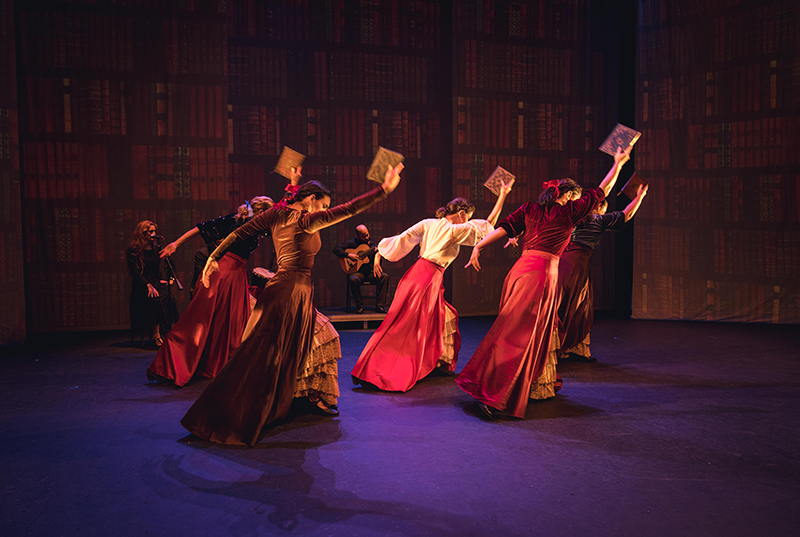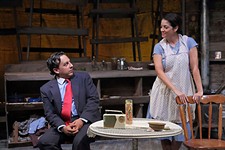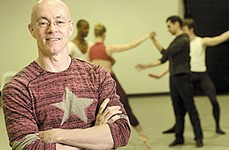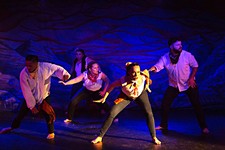A’lante Flamenco’s Juana: First (I) Dream
The dramas of Sor Juana Inés de la Cruz were perfectly expressed through the language of flamenco
Reviewed by Jonelle Seitz, Fri., Jan. 12, 2018
It was a furious, delirious beginning: Olivia Chacón's heels hammering the floor, a long white skirt whipping around her calves, as flamenco singer Celia Sellers sustained a wide, wavering note. In the next moment, a sextet of altogether different singers, dressed in somber black, offered up the polyphonic notes of a baroque motet, encircling Chacón as she indulged in some loosening neck rolls. We heard the slow scraping of the edge of her shoe against the floor, and then her wrists circled and flexed, their flourishes mirroring the cursive of the handwritten manuscript projected behind her, before her hands closed in prayer.
The dramas of the title character of Juana: First (I) Dream, a fiery intellectual woman bucking against and succumbing to the constraints of her time, were perfectly expressed through the language of flamenco. Sor Juana Inés de la Cruz, born around 1650 in colonial Mexico, reportedly learned Latin at age 3 and begged her mother to let her disguise herself as a boy so she could attend university. Mamá refused, so after a stint as a lady-in-waiting in the court of the viceroy and fending off several marriage proposals, Juana joined a convent. Her second convent (she stayed only a few months at the first, as its austerity clashed with her progressive nature) allowed her to spend her time reading, writing, philosophizing, and learning. That is, until a bishop stole some of her ideas and decided she needed to devote herself completely to prayer. Soon after, she died of a plague, at the age of 43. Aiyiyi, and olé!
A'lante Flamenco's evocation of this oh-so-timeless tale, choreographed by Chacón and with musical arrangements by Isai Chacón, José Manuel Tejeda, and Daniel Johnson, was rife with the contrasts that must have racked Sor Juana's being. The bishop who yoked her with her rebozo and yanked the books from her and her sisters' hands, placing them instead atop their heads in a posture exercise, was certainly the antagonist, but it seemed impossible to align maleficence with the heavenly voices of the guest singers from the Texas Early Music Project. In fact, one gift of this performance was the notion that in Juana herself, just as in this retelling, these juxtapositions must have hung together in a brilliant, dynamic whole, however hopelessly contradicted. Sacred baroque songs were interwoven and even mashed up with the rhythms and plaints of the A'lante Flamenco musicians. Projections on towering backdrop panels alternated Sor Juana's writing, with ink blotches and cross-outs, with striking paintings of colonial Mexico's monjas coronadas, nuns crowned with flowers.
Four dancers who wore velvet, tiered ruffles, and heels in the first act reappeared in the second as nuns, unshrouded for the evening, in white. With bare feet, and without the rumbling rhythms that had before seemed like organic emanations of their being, they were vulnerable and touchingly awkward, as one might imagine nuns in their nightgowns to be. The Juana role was split between two dancers: the fresh-faced, thin-armed Carisa Leal as the younger Juana, and the taller, more formidable Chacón as the mature Juana in Act II. When the nuns lay down to rest, Juana rose in a dream, with Chacón's fingers flying on castanets and her feet flying quietly across the stage. It wasn't long before the bishop, danced by Guillermo Tabares, took hold of Juana. Although she did put up a fight, back in heels and challenging him with flashing ankles and a straight back, an earlier melting backbend had foreshadowed her relent. Her arms flew out to her sides and to the sky in the sign of the cross, and she shoved her books from her desk. Smartly, this was where it ended – we didn't need to see the intellectually impoverished Juana tending to the ill or catching her own death. And of course, as this was flamenco, there was an encore, where everyone was celebrated, the rhythms were catching, and everyone, including the villain and the doomed, went out dancing.
Juana: First (I) Dream
Rollins Studio Theatre at the Long Center, 701 W. Riversidewww.alanteflamenco.com
Through Jan. 14
Running time: 1 hr., 15 min.













